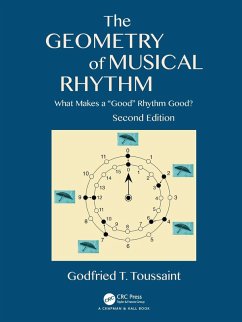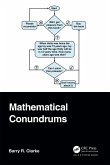The original edition of The Geometry of Musical Rhythm was the first book to provide a systematic and accessible computational geometric analysis of the musical rhythms of the world. It explained how the study of the mathematical properties of musical rhythm generates common mathematical problems that arise in a variety of seemingly disparate fields. The book also introduced the distance approach to phylogenetic analysis and illustrated its application to the study of musical rhythm. The new edition retains all of this, while also adding 100 pages, 93 figures, 225 new references, and six new chapters covering topics such as meter and metric complexity, rhythmic grouping, expressive timbre and timing in rhythmic performance, and evolution phylogenetic analysis of ancient Greek paeonic rhythms. In addition, further context is provided to give the reader a fuller and richer insight into the historical connections between music and mathematics.
Hinweis: Dieser Artikel kann nur an eine deutsche Lieferadresse ausgeliefert werden.
Hinweis: Dieser Artikel kann nur an eine deutsche Lieferadresse ausgeliefert werden.
"The late Godfried Toussaint studied the rhythms of the world like a gold panner, collecting with meticulousness and passion all the motifs that different cultures have given birth to. Thanks to his skill as a mathematician, he extracted fascinating properties from them. There is no doubt that this unique book will survive for a very long time."
-Marc Chemillier, Directeur d'études, École des Hautes Études en Sciences Sociales
"Through the original use of distance geometry for analyzing musical rhythm and the visualization of rhythms as cyclic polygons, Gottfried Tousssaint's fascinating book will be extremely valuable to any researcher involved in in the field of rhythm."
-Simha Arom, Ethnomusicologist
"The new edition of The Geometry of Musical Rhythm takes us further along Godfried Toussaint's journey through the world's rhythms. There are new discussions of metric complexity, rhythm visualization, rhythmic performance, and the evolution of rhythmic patterns. Almost every chapter has been expanded and informed by the latest scholarship in music theory, music psychology, ethnomusicology, and music informatics. Specialists and lay readers alike will find this edition even more engaging and valuable than the first, giving us even more reasons to delight in what makes a "good" rhythm good."
- Professor Justin London, Carleton College
"A unique and seminal work of original and meticulously detailed scholarship, this newly published second edition of "The Geometry of Musical Rhythm : What Makes a "Good" Rhythm Good?" is unreservedly recommended as a core addition to both college and university library collections."
-Midwest Book Review
Praise for the previous edition
"Toussaint's Geometry presents a whirlwind tour of the world's rhythms ... For a reader interested in musical rhythm, Geometry is a great introduction to the computer science and mathematics of rhythm. For a reader interested in algorithms and mathematical reasoning, the musical focus provides compelling examples lying at the intersection of the arts and the sciences."
-William A. Sethares, Journal of Mathematics and the Arts, 2014
"... a delightful, informative, and innovative study in the geometric interpretation of rhythm. ... It is a pleasure to find an author who has such good command of mathematics and music and who can explain their interconnections with such literary skill. I recommend this book wholeheartedly to every serious student of geometry and music."
-Ilhan M. Izmirli, Mathematical Reviews, March 2014
"This dynamic fluid presentation of mathematics is exactly what our undergraduate and graduate students need. ... I would highly recommend this book for everyone."
-Russell Jay Hendel, MAA Reviews, May 2013
-Marc Chemillier, Directeur d'études, École des Hautes Études en Sciences Sociales
"Through the original use of distance geometry for analyzing musical rhythm and the visualization of rhythms as cyclic polygons, Gottfried Tousssaint's fascinating book will be extremely valuable to any researcher involved in in the field of rhythm."
-Simha Arom, Ethnomusicologist
"The new edition of The Geometry of Musical Rhythm takes us further along Godfried Toussaint's journey through the world's rhythms. There are new discussions of metric complexity, rhythm visualization, rhythmic performance, and the evolution of rhythmic patterns. Almost every chapter has been expanded and informed by the latest scholarship in music theory, music psychology, ethnomusicology, and music informatics. Specialists and lay readers alike will find this edition even more engaging and valuable than the first, giving us even more reasons to delight in what makes a "good" rhythm good."
- Professor Justin London, Carleton College
"A unique and seminal work of original and meticulously detailed scholarship, this newly published second edition of "The Geometry of Musical Rhythm : What Makes a "Good" Rhythm Good?" is unreservedly recommended as a core addition to both college and university library collections."
-Midwest Book Review
Praise for the previous edition
"Toussaint's Geometry presents a whirlwind tour of the world's rhythms ... For a reader interested in musical rhythm, Geometry is a great introduction to the computer science and mathematics of rhythm. For a reader interested in algorithms and mathematical reasoning, the musical focus provides compelling examples lying at the intersection of the arts and the sciences."
-William A. Sethares, Journal of Mathematics and the Arts, 2014
"... a delightful, informative, and innovative study in the geometric interpretation of rhythm. ... It is a pleasure to find an author who has such good command of mathematics and music and who can explain their interconnections with such literary skill. I recommend this book wholeheartedly to every serious student of geometry and music."
-Ilhan M. Izmirli, Mathematical Reviews, March 2014
"This dynamic fluid presentation of mathematics is exactly what our undergraduate and graduate students need. ... I would highly recommend this book for everyone."
-Russell Jay Hendel, MAA Reviews, May 2013








